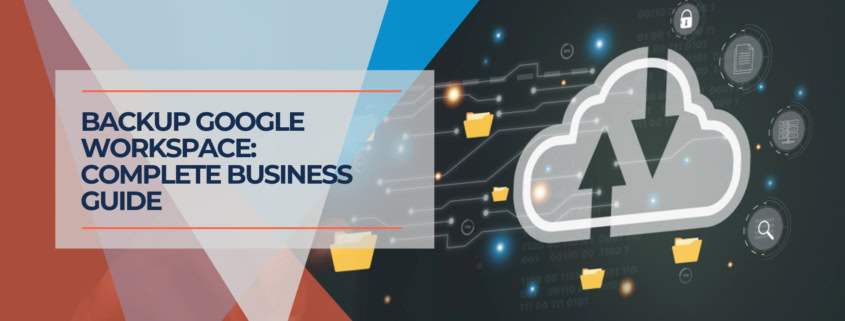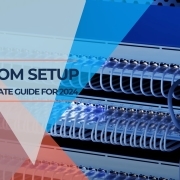Complete Google Workspace Backup Guide for Small Business (2025)
Published: October 16, 2025 | Last updated: October 16, 2025
Key Takeaway: Google Workspace's native tools protect against platform failures, but they don't safeguard your business data against the most common threats: accidental deletion, malicious insider activity, ransomware, or compliance violations. A proper backup strategy requires a third-party solution that creates independent copies of your emails, files, calendars, and contacts—with the ability to restore granularly and meet industry-specific retention requirements.
- Recovery gap: Google provides 30 days to recover from trash plus 25 additional days for admin recovery, but this 55-day maximum often falls short of compliance requirements and real-world data loss scenarios
- Cost of inaction: Small businesses that experience significant data loss face average recovery costs of $50,000-$150,000 when accounting for lost productivity, business disruption, and potential compliance penalties
- Implementation time: Most backup solutions can be configured and operational within 2-4 hours, with automated daily backups thereafter
Table of Contents
- 1 Why Google Workspace Native Backup Isn't Enough
- 2 Compliance Requirements and Data Retention Standards
- 3 What Data Needs Backing Up in Google Workspace
- 4 Backup Solution Comparison: Cloud vs Local
- 5 Step-by-Step: Setting Up iDrive for Google Workspace
- 6 Step-by-Step: Setting Up Synology Active Backup for Google Workspace
- 7 Recovery Scenarios and Testing Procedures
- 8 Cost Analysis: Backup Investment vs Data Loss
- 9 Advanced Considerations and Best Practices
- 10 Frequently Asked Questions
- 10.0.1 How is third-party backup different from Google Workspace's built-in data protection?
- 10.0.2 Does backing up Google Workspace data violate any Google terms of service?
- 10.0.3 How long does the initial backup take for a typical small business?
- 10.0.4 Can I restore data to a different Google Workspace account?
- 10.0.5 What happens if my backup solution company goes out of business?
- 10.0.6 Do I need to back up Google Workspace if I already use Vault?
- 10.0.7 How much storage do I need for Google Workspace backup?
- 10.0.8 Can backup solutions protect against ransomware affecting Google Workspace?
- 10.0.9 What's the difference between backup and archive?
- 10.0.10 How often should I test backup recovery?
- 11 Next Steps: Implementing Your Google Workspace Backup Strategy
Why Google Workspace Native Backup Isn't Enough
Google Workspace provides robust infrastructure reliability with 99.9% uptime guarantees and protects your data from platform-level failures. However, this infrastructure protection doesn't cover small businesses' most common data loss scenarios.
When an employee accidentally deletes an important email thread, a departing team member removes shared files, or ransomware encrypts your Google Drive through a compromised account, Google's native tools offer limited recovery options. Deleted items remain in trash for 30 days, after which administrators have an additional 25-day window to recover them—providing a maximum 55-day recovery period. Beyond this window, data becomes unrecoverable through standard methods.
What Google Workspace Doesn't Protect Against:
User error and accidental deletion: An employee permanently deletes a folder containing months of project documentation. After the 55-day recovery window expires, it's gone forever.
Malicious insider activity: A disgruntled employee with admin access systematically deletes critical business data before departing. By the time you discover the extent of the damage, the retention window has passed.
Ransomware and account compromise: Attackers gain access through phishing and encrypt or delete files across your entire Google Drive. If the attack persists over time, Google's version history may be compromised.
Compliance and legal holds: Your industry requires 7-year email retention, but Google Workspace's standard tools don't automatically enforce this across all accounts without significant administrative overhead.
The challenge becomes more acute when you consider securing your cloud workspace involves more than just platform-level protections. You need independent backup copies that exist outside your primary Google account structure, protected by separate credentials and access controls.
Google Workspace's Vault service addresses some compliance needs for legal holds and retention policies, but operates within the same account structure. If an admin account is compromised or if you need to restore data after your retention window expires, Vault can't help. This is where third-party backup solutions become essential for business continuity.
Compliance Requirements and Data Retention Standards
Different industries face varying regulatory requirements for data retention and availability. Understanding your specific obligations helps determine your organization's appropriate backup strategy and retention schedule.
Industry-Specific Retention Requirements
Healthcare organizations subject to HIPAA must retain patient communications and records for at least six years from creation or the last effective date. This applies to emails containing protected health information (PHI), shared documents with patient data, and calendar entries documenting patient interactions. Our compliance guide covers the technical controls required for HIPAA-compliant backups.
Financial services firms operating under SEC regulations face stringent requirements: all business-related communications must be retained for at least six years, with the first two years in an easily accessible format. This includes email, instant messages (if using Google Chat), and documents containing financial advice or transaction records.
Legal practices must retain client files and communications according to their jurisdiction's rules of professional conduct, typically ranging from 5-10 years after case closure. Many states now explicitly include electronic communications and cloud-stored documents in their retention requirements.
Even without specific industry regulations, general business records should be retained for seven years to cover IRS audit windows for tax-related documentation. This includes emails containing financial decisions, contracts stored in Google Drive, and calendar records of business meetings.
Key Compliance Features in Backup Solutions
Point-in-time recovery is the ability to restore data as it existed on any specific date within your retention period. This is crucial for responding to legal discovery requests or compliance audits.
Immutable backups are backup copies that cannot be altered or deleted, even by administrators, protecting against ransomware and insider threats.
Audit logging: Comprehensive records of all backup and restore operations, including who performed them and when, supporting compliance documentation requirements.
Encryption at rest and in transit: All backup data must be encrypted using industry-standard protocols, with secure key management separate from production systems.
Granular retention policies: The ability to set different retention periods for various types of data or different user groups, accommodating varying regulatory requirements within a single organization.
European businesses must also consider GDPR's “right to be forgotten” alongside retention requirements—a complex balance requiring backup solutions that selectively remove individual user data while maintaining compliance records for other retained information.
What Data Needs Backing Up in Google Workspace
A comprehensive Google Workspace backup strategy must account for all business-critical data across the platform's integrated services. Understanding what each service contains helps prioritize backup configurations and recovery testing.
Gmail: More Than Just Email
Gmail backups must capture complete message content, including all attachments, metadata (sender, recipient, timestamps), folder organization, labels, and thread relationships. Many businesses overlook that Gmail also stores important context: email signatures containing contact information, filters and forwarding rules that automate business processes, and delegated access permissions that may be needed for recovery scenarios.
A complete Gmail backup should preserve messages exactly as they appear in the interface, with all formatting, embedded images, and attachment relationships intact. This ensures restored emails maintain their original context and usability.
Google Drive: Files and Sharing Permissions
Drive backups require more than just file content. You need to preserve the folder structure and organization, sharing permissions and access levels, file comments and collaborative annotations, and version history for important documents. When an employee leaves or makes changes, you want to restore the file and the entire collaboration context.
Shared drives (formerly Team Drives) add another layer of complexity. These organizational storage areas have their own permission structures and membership rules that must be backed up separately from individual user drives. A proper backup solution handles personal and shared drive content equally thoroughly.
Google Calendar: Business Scheduling and Context
Calendar data represents significant business value that's often underestimated. Backups should include all event details and descriptions, attendee lists and invitation status, recurring event patterns, and attached files or meeting notes. Calendar data often provides crucial timeline information for project reconstruction or legal discovery.
Resource calendars for conference rooms or equipment also need backing up, as they document facility usage and can support billing or allocation decisions. Many businesses only realize the value of historical calendar data when they need to reconstruct a project timeline or respond to a legal question about meeting attendance.
Google Contacts: Relationship Management
Contact backups preserve complete contact information, custom fields and notes, contact groupings and labels, and links to related calendar events and emails. While contacts might seem less critical than other data types, reconstructing your business contact database from memory proves time-consuming and error-prone.
For sales and client service teams, contact notes and historical interaction records in Google Contacts often contain irreplaceable relationship context. A backup solution should treat contacts as first-class data worthy of the same protection as emails and files.
Additional Workspace Components
Depending on your Google Workspace plan, you may also need to consider backing up Google Sites if you use them for internal wikis or project documentation, shared Google Forms and their response data, Google Chat history if you use it for team communication, and Google Keep notes if teams use them for project tracking or documentation.
Each additional service adds to the complexity of your backup strategy but may contain business-critical information that would be difficult or impossible to recreate.
Backup Solution Comparison: Cloud vs Local
Small businesses typically choose between cloud-based backup services and local backup appliances. Each approach offers distinct advantages; some organizations implement both for comprehensive protection.
Cloud Backup Solutions: iDrive for Google Workspace
Cloud backup solutions like iDrive store your Google Workspace data in an independent cloud infrastructure, creating genuine off-site redundancy. This approach offers several advantages for small business environments.
iDrive for Google Workspace
Key Features:
Set up simplicity: Authentication through Google's OAuth means no complex server deployment or maintenance. You authorize iDrive to access your Workspace data and configure backup schedules, and the system handles everything else.
Automatic daily backups: Once configured, iDrive runs daily incremental backups, capturing any changes to emails, files, calendars, and contacts. Full backups run weekly, with incremental changes captured continuously.
Extended retention: Unlike Google's 30-day trash retention plus 25-day admin recovery window, iDrive maintains your backup history indefinitely according to your configured retention policy. Set a 7-year retention for compliance, and the system automatically maintains that window.
Granular recovery: You can restore individual emails, specific file versions, single calendar events, or entire user accounts. The recovery scope is chosen based on your specific needs.
Cross-account recovery: This method restores data from one user's backup into another user's account. It is useful when employees transition roles or when data needs to be consolidated after organizational changes.
iDrive uses bank-level 256-bit AES encryption for data in transit and at rest. Your backup data is stored in geographically distributed data centers with redundancy exceeding Google's infrastructure specifications. The service includes detailed audit logs showing every backup and restore operation, supporting compliance documentation requirements.
Pricing is straightforward: $20 per user per year, with each seat including 10 TB of storage—far exceeding typical small business needs. Additional storage, if required, costs $5 per TB per month.
Local Backup Solution: Synology Active Backup for Google Workspace
Local backup solutions provide an alternative approach where backup data resides on hardware you control. Synology NAS devices offer Active Backup for Google Workspace as part of their DSM operating system at no additional licensing cost.
Synology Active Backup: Key Features
One-time hardware cost: After purchasing a Synology NAS device, the Active Backup software is included at no recurring licensing fee. This creates long-term cost advantages for larger organizations.
Local data control: Backup data never leaves your premises, appealing to organizations with strict data sovereignty requirements or those handling highly sensitive information.
Integration with broader backup strategy: The same Synology device can back up workstations, servers, virtual machines, and other business systems, creating a unified backup infrastructure. This is detailed in our comprehensive backup solutions guide.
Snapshot protection: Synology's Btrfs filesystem creates point-in-time snapshots of backup data, protecting against both ransomware and accidental deletion at the storage level.
Flexible recovery options: You can restore through the web interface, mount backups for browse-and-recover access, or export data in standard formats for migration to other platforms.
The local backup approach requires more initial setup and ongoing maintenance than cloud solutions. You need to size the NAS appropriately for your Google Workspace data volume, implement your own off-site replication strategy, manage hardware lifecycle and capacity planning, and maintain network infrastructure for reliable backup operations.
A hybrid approach makes sense for many small businesses: Synology Active Backup for primary, fast recovery scenarios, with a secondary cloud backup service providing off-site redundancy and long-term archival. This balances cost control with comprehensive protection.
Decision Framework: Which Solution Fits Your Business
Cloud backup (iDrive) makes sense when:
- Your team is fully distributed with no central office location
- You want minimal IT overhead and maintenance burden
- You prefer predictable annual costs without upfront capital investment
- You need guaranteed off-site redundancy without managing replication
- You want rapid deployment without hardware procurement and setup
- Your team size is under 50 users (where the $20/seat/year pricing remains highly affordable)
Local backup (Synology) makes sense when:
- You maintain a physical office with reliable power and internet infrastructure
- Data sovereignty or regulatory requirements favor on-premises storage
- You already manage local IT infrastructure and have technical resources
- You want to integrate Google Workspace backup with broader system backup needs (workstations, servers, etc.)
- You need the fastest possible local recovery times for large data sets
- You prefer capital investment with lower ongoing costs over subscription services
Step-by-Step: Setting Up iDrive for Google Workspace
Cloud backup setup typically takes 2-4 hours, including initial configuration, policy setup, and verification of the first backup cycle. The following process assumes you have Google Workspace admin credentials and have selected your backup solution.
Initial Setup and Authorization
If you don't already have an iDrive business account, create one. Then, navigate to the Google Workspace backup section and initiate the setup wizard. The system will prompt you to authorize iDrive's access to your Google Workspace domain.
Click the authorization link to redirect you to Google's OAuth consent screen. Review the permissions iDrive requests: read access to Gmail, Drive, Calendar, and Contacts. These permissions allow iDrive to copy your data but not modify anything in your production Google Workspace environment.
Sign in with your Google Workspace super admin account and grant the requested permissions. Google will display a confirmation and redirect you back to iDrive's console with authorization complete. This OAuth token allows iDrive to access your Workspace data according to the permissions granted, which you can revoke at any time through Google's security settings.
Configuring Backup Policies
With authorization complete, configure which data gets backed up and how often. Select the Workspace services to include in your backup: Gmail, Google Drive, Calendar, Contacts, and any additional services your plan supports. For most small businesses, backing up all services ensures comprehensive protection.
Set your backup schedule. Daily backups at 2:00 AM work well for most organizations, running during low-activity hours to minimize performance impact. Configure the schedule for your local time zone to ensure backups are completed before your business day begins.
Define your retention policy based on compliance requirements. A standard business configuration might use 30 days for deleted items, 1 year for standard retention, and 7 years for compliance-critical data categories. iDrive allows different retention policies for various data types, letting you balance storage costs with regulatory requirements.
User Selection and Exclusions
Review your Google Workspace user list and select accounts to include in backups. Most organizations back up all user accounts, but you may exclude resource accounts, test accounts, or temporary contractor access that don't contain business-critical data.
Consider discussing a backup scope for users with large amounts of personal data in Drive. Some organizations exclude personal folders while backing up shared drives and business-related individual folders. Document any exclusions in your backup policy documentation.
Initial Backup Execution
Initiate your first full backup. Depending on your data volume, this may take several hours to complete. A small business with 10 users typically has 50-200 GB of Google Workspace data, which takes 2-6 hours for initial backup over typical business internet connections.
Monitor the backup progress through iDrive's dashboard. The console displays which users have completed backup, current data transfer rates, and estimated completion time. If errors occur during initial backup (often due to huge files or permission issues), the system logs them for review.
Once the initial backup completes, subsequent daily incremental backups capture only changes since the last backup. Depending on your organization's daily data changes, these typically complete in 15-45 minutes.
Verification and Testing
Never assume backups work without testing. Within 48 hours of completing your initial backup, perform a test restore of a few items: a recent email, a Google Drive file, a calendar event, and a contact entry. Verify that the restored data is complete and intact.
Document your test restore process and results. Many compliance frameworks require backups and regular restore testing to verify backup integrity. Schedule quarterly restore tests as part of your ongoing backup verification process.
Step-by-Step: Setting Up Synology Active Backup for Google Workspace
Local backup deployment requires more initial setup than cloud solutions, but provides long-term cost advantages and data control benefits. This process assumes you have a Synology NAS device running DSM 7.0 or later.
Hardware Preparation
Ensure your Synology NAS has adequate storage capacity for your Google Workspace data with room for growth. A good rule of thumb is to provision 3-5 times your current Google Workspace storage capacity to accommodate backup retention and growth over 2-3 years.
For a business with 15 users averaging 10 GB per user (150 GB total), deploy a NAS with at least 500 GB available after accounting for RAID overhead and system requirements. The Synology DS923+ with four 4TB drives in RAID 5 provides over 10 TB usable capacity, supporting substantial growth.
Configure your NAS with a static IP address on your local network and ensure it has reliable internet connectivity for communicating with Google's APIs. Place the device on a UPS to protect against power interruptions during backup operations.
Installing and Configuring Active Backup
Log in to your Synology's DSM interface and navigate to Package Center. Search for “Active Backup for Google Workspace” and install the package. The installation typically takes 2-3 minutes.
Launch Active Backup from the main menu and complete the initial setup wizard. Similar to cloud backup solutions, the interface prompts you to authorize access to your Google Workspace domain. Click “Add Google Workspace” and follow the OAuth authorization flow.
Synology's authorization process requires super admin access to your Google Workspace account. Review the requested permissions carefully—Active Backup needs read access to backup your data, but doesn't require any modification permissions. Complete the authorization and return to the Active Backup interface.
Creating Backup Tasks
Create a new backup task in Active Backup, selecting your authorized Google Workspace domain. Choose which services to back up: Gmail, Drive, Calendar, and Contacts. Unlike some cloud solutions, Synology backs up all selected services as part of a single task, simplifying management.
Configure your backup schedule. Active Backup supports flexible scheduling: daily backups at specific times, multiple daily backups for high-change environments, or continuous backup where the system monitors for changes and backs up frequently throughout the day.
Set retention policies for your backup task. Synology offers version-based retention (keep last 50 versions), time-based retention (keep all versions for 1 year), or combination approaches. A typical business configuration keeps 30 daily versions, 12 monthly versions, and 7 annual versions, providing granular short-term recovery with long-term compliance retention.
Implementing Off-Site Replication
Local backup provides fast recovery but doesn't protect against site-level disasters. Implement off-site replication to a second Synology device in another location, or use Synology's C2 Backup cloud service to replicate your backup data.
Configure Active Backup's replication feature to send a copy of your Google Workspace backups to a second NAS device for two-site replication. This device can be located at a business owner's home, a second office location, or a colocation facility. Schedule replication to run after daily backups are complete, typically during overnight hours.
Alternatively, subscribe to Synology C2 Backup and configure it to replicate your Active Backup data to Synology's cloud infrastructure. This hybrid approach maintains local backup for fast recovery while ensuring off-site protection without managing a second physical device.
Initial Backup and Verification
Start your first backup task and monitor its progress through Active Backup's dashboard. The interface shows the real-time status of each user account being backed up, data transfer rates, and estimated completion time.
Initial backup over a local network connection typically completes faster than cloud backup since you're not limited by internet upload bandwidth. However, Google's API rate limits may throttle large initial backups, with the system automatically adjusting speed to stay within Google's quotas.
Once the initial backup completes, test recovery immediately.
Active Backup offers several recovery options: restore to original location, restore to alternate account, or export data to standard file formats. Test each method you might need in an actual recovery scenario.
Recovery Scenarios and Testing Procedures
Effective backup strategies include regular testing of recovery procedures. Understanding common recovery scenarios helps you prepare for real-world data loss events and verify your backup solution performs as expected when needed.
Scenario 1: Accidental Email Deletion
An employee permanently deletes an important email thread and empties their trash. Three weeks later, they need information from those messages for a client proposal. Since Google's trash retention is 30 days and the messages were deleted three weeks ago, standard recovery methods will work for another week.
Using your backup solution, search for emails from the affected timeframe using sender, subject, or date filters. Both iDrive and Synology Active Backup offer email search across your entire backup history. Locate the deleted thread, verify it contains the needed information, and restore it to the user's mailbox.
Most backup solutions allow you to restore the email to a special folder (like “Recovered Items”) rather than its original location, helping users distinguish restored content from current data. The entire recovery process typically takes 5-10 minutes.
Scenario 2: Ransomware File Encryption
An employee clicks a phishing link, compromising their Google Workspace credentials. Attackers gain access and systematically encrypt files across the user's Google Drive and all shared drives they can access. You discover the attack four days later when multiple users report that files appear corrupted.
Immediately revoke the compromised account's sessions and reset credentials. Then assess the scope of damage using your backup solution's change logs—both iDrive and Active Backup maintain detailed records of file modifications, helping you identify which files were affected and when the attack began.
Perform a point-in-time restore of all affected Google Drive content from the backup taken immediately before the attack started. For a shared drive with 500 files, this recovery typically takes 30-60 minutes. The ransomware attack shouldn't affect your backup copies because your backup data exists in a separate infrastructure with different credentials.
This scenario highlights why independent backup copies matter. If you relied solely on Google Drive's version history, and attackers maintained access for several days, they could have deleted or encrypted the version history alongside the primary files.
Scenario 3: Departing Employee Data Removal
An employee gives two weeks' notice, and during their final days, they delete personal copies of client contact information and project files from their Google Drive, believing they're removing their personal data. Unfortunately, some of these were unique copies not stored in shared drives, containing valuable client notes and project context.
A colleague needs information from those deleted files to continue a project two months after the employee's departure. Google's standard retention has long since expired, but your backup solution maintains one-year retention.
Navigate to the departed employee's backup, browse their Google Drive as it existed on their last day of employment, and locate the needed files. Restore them to a current employee's account or a shared drive for team access. This recovery might save dozens of hours of work reconstructing client relationship details and project context.
Scenario 4: Compliance and Legal Hold Recovery
Your business receives a legal discovery request for all emails and documents related to a specific project from 18 months ago. While Google Workspace Vault could handle some of this if you had legal holds configured, you need to provide data in particular formats for the legal team, including email in PST format and documents in their native applications.
Locate all relevant emails and files from the specified timeframe using your backup solution's search and export features. Create an export package containing everything matching the discovery request criteria. Both iDrive and Synology Active Backup support exporting email to a standard PST format that legal teams can process with eDiscovery tools.
This capability becomes essential when discovery requests span timeframes before you implemented Google Workspace Vault, or when you need to provide data in formats different from Google's native export options.
Testing Schedule and Documentation
Implement a quarterly backup testing schedule that rotates through different recovery scenarios. Document each test with details about what was recovered, time required, any issues encountered, and lessons learned.
Quarterly Testing Rotation:
Q1: Test individual email recovery for three different users, including search functionality and restore verification
Q2: Test Google Drive file recovery, including shared drive content and preservation of sharing permissions
Q3: Test point-in-time recovery to restore all data for a single user account as it existed 30 days ago
Q4: Test export functionality for compliance reporting, generating PST email archives, and document packages
Store test documentation securely accessible to your IT team and business continuity planning. This documentation proves invaluable during actual recovery events and demonstrates due diligence for compliance audits.
Cost Analysis: Backup Investment vs Data Loss
Understanding the actual cost of Google Workspace backup requires comparing implementation and ongoing expenses against potential data loss impacts. Many small businesses underestimate data loss risks until they experience a significant incident.
Cloud Backup Cost Structure (iDrive)
iDrive charges per-user annual fees with straightforward pricing. For a 10-user small business:
| Cost Component | First Year | Ongoing (Year 2+) |
|---|---|---|
| User licenses (10 users @ $20/seat/year) | $200/year | $200/year |
| Setup and configuration | $200 (one-time) | — |
| Storage (10 TB per seat included) | Included | Included |
| Additional storage (if needed) | $5/TB/month | $5/TB/month |
| Annual testing and verification | $150 | $150/year |
| Total Annual Cost | $550 | $350/year |
Each seat includes 10 TB of storage, which is far more than most small business users require. A typical Google Workspace user with 10-50 GB of data has substantial room for growth and multiple backup versions within the included storage quota.
Local Backup Cost Structure (Synology)
Synology's local backup approach has higher upfront costs but lower ongoing expenses:
| Cost Component | Initial Investment | Annual Ongoing |
|---|---|---|
| Synology DS923+ NAS | $550 | — |
| 4x 4TB drives (RAID 5) | $480 | — |
| Setup and configuration | $400 | — |
| UPS for power protection | $200 | — |
| Off-site replication (C2 Backup) | — | $240/year |
| Annual testing and maintenance | — | $200/year |
| Total First Year | $2,070 | — |
| Annual Ongoing (Year 2+) | — | $440/year |
The Synology approach requires a higher upfront investment but offers lower ongoing costs. With iDrive at $350/year ongoing versus Synology at $440/year, the cloud solution remains more cost-effective for this size deployment. However, Synology's advantage emerges when backing up additional business systems—the same hardware can protect workstations, servers, and other data, potentially replacing multiple backup services and justifying the higher initial investment.
Cost of Data Loss: Real-World Impact
Compare backup costs against potential data loss scenarios:
Scenario: Loss of 3 months of email history: Reconstructing client communications, project timelines, and business decisions could require 40-80 hours of employee time across multiple staff members. A blended rate of $75/hour represents $3,000-$6,000 in direct labor costs, plus the opportunity cost of delayed projects and reduced productivity.
Scenario: Ransomware affects Google Drive: If attackers encrypt critical business files and you have no independent backup, you face the decision to either pay the ransom (the average demand is $20,000-$50,000 for small businesses) or recreate content from scratch. Recreation might be impossible for some unique documents, potentially affecting client relationships and contract obligations.
Scenario: Compliance violation due to inability to produce records: Regulatory fines for failure to maintain and produce required records vary by industry but can reach $10,000-$50,000 for first violations, with potential for civil liability if the data loss affects customer or patient information.
Scenario: Employee departure with data deletion: The loss of unique client relationship information and project documentation might cost 20-40 hours to reconstruct, with a partial permanent loss of some context. The direct cost is $1,500-$3,000 in staff time, plus potentially damaged client relationships from incomplete information.
Most small businesses that experience significant data loss report total recovery costs of $50,000-$150,000 when factoring in direct recovery expenses, lost productivity, delayed projects, compliance issues, and reputation damage. A backup solution costing $500-$2,000 annually represents insurance against these catastrophic scenarios.
Advanced Considerations and Best Practices
Beyond basic backup implementation, several advanced considerations help optimize your Google Workspace protection strategy.
Integration with Broader Backup Strategy
Google Workspace backup should integrate with your complete business backup approach. Many organizations use unified backup management to back up Google Workspace data alongside local workstations, servers, and other cloud services. Our comprehensive backup guide covers multi-platform backup strategies for small business environments.
Consider how Google Workspace backup relates to other data protection measures. If you're implementing encrypted cloud storage for particularly sensitive files, ensure that your backup strategy covers those. Some organizations maintain separate backup policies for different data sensitivity levels.
Automation and Monitoring
Configure automated alerts for backup failures, completion confirmations, and unusual activity patterns. Both cloud and local backup solutions support email or SMS notifications when backups are not completed successfully, when data volumes change dramatically (a potential indicator of problems), or when retention policies need attention due to storage constraints.
Implement a monthly review process where someone verifies backup status, reviews completion logs, and confirms adequate storage capacity. This 15-minute monthly check prevents situations where backups fail silently for weeks before anyone notices.
Security Considerations
Protect access to your backup system with the same rigor you apply to production Google Workspace data. Use separate administrative credentials for backup management rather than your primary Workspace admin account. Enable multi-factor authentication on all backup system access.
For organizations with compliance requirements, implement role-based access control where different staff members have different backup permissions. Your help desk might need restore capabilities without full backup configuration access, while your IT manager needs complete control.
Review backup system audit logs quarterly as part of your security audit process. Unusual restore patterns or unexpected configuration changes warrant investigation.
Scaling and Growth Planning
As your organization grows, reassess your backup solution. Cloud backup solutions scale linearly (add users, pay proportionally more), making them straightforward to expand but potentially expensive at a larger scale. Local solutions require periodic hardware upgrades but maintain lower per-user costs.
Plan for data growth beyond just user count. Increased use of Google Drive for collaboration, longer email retention as your business matures, and accumulating historical data all increase backup storage requirements. Project 20-30% annual growth in backup data volume, even if the user count remains stable.
Frequently Asked Questions
How is third-party backup different from Google Workspace's built-in data protection?
Google Workspace protects against infrastructure failures and maintains short-term version history, but it doesn't protect against user error, malicious deletion, or ransomware, nor does it provide long-term retention required for many compliance frameworks. Third-party backup creates independent copies of your data in a separate infrastructure, protected by different credentials, with retention periods you control rather than Google's 30-day trash plus 25-day admin recovery window.
Does backing up Google Workspace data violate any Google terms of service?
No. Google explicitly supports third-party backup through its APIs and OAuth authorization system. Many enterprise Google Workspace customers use backup solutions for compliance and business continuity strategies. Google provides detailed API documentation specifically for backup solution developers.
How long does the initial backup take for a typical small business?
The duration of the initial backup depends on the total data volume and your internet connection speed. A 10-user business with 150 GB of Google Workspace data typically completes the initial backup in 4-8 hours over a standard business internet connection. Cloud solutions may take longer due to upload bandwidth limitations, while local Synology backup runs faster over local network connections but is still subject to Google API rate limits.
Can I restore data to a different Google Workspace account?
Yes. Most backup solutions support cross-account restore, allowing you to recover data from one user's backup into a different user's account. This proves helpful when employees transition roles, need to consolidate data after organizational changes, or restore departed employee data for ongoing business needs.
What happens if my backup solution company goes out of business?
For cloud backup solutions, check whether they offer data export capabilities and what format your data is stored in. Reputable providers maintain data export tools and would provide transition periods if discontinuing service. For local backup solutions like Synology, you own the hardware and data, eliminating vendor dependency—your backup data remains accessible regardless of the software vendor's business status.
Do I need to back up Google Workspace if I already use Vault?
Google Vault addresses legal hold and compliance retention requirements but operates within your Google Workspace environment. It doesn't protect against admin account compromise, doesn't offer the same granular recovery capabilities as dedicated backup solutions, and may not meet all compliance requirements for independent backup copies. Many organizations use both: Vault for legal holds and eDiscovery, backup solutions for operational recovery, and comprehensive data protection.
How much storage do I need for Google Workspace backup?
Plan for 2-3 times your current Google Workspace storage consumption to accommodate retention of multiple versions and data growth. A business using 200 GB in Google Workspace should initially provide 400-600 GB backup storage. Cloud backup solutions typically don't require upfront capacity planning (storage expands automatically), while local solutions need adequate disk capacity from the start.
Can backup solutions protect against ransomware affecting Google Workspace?
Yes, if implemented correctly. Because backup data exists in a separate infrastructure with different credentials, ransomware that compromises your Google Workspace account cannot affect your backup copies. However, ensure your backup system uses unique administrative credentials and multi-factor authentication so attackers cannot pivot from Google Workspace access to backup system access.
What's the difference between backup and archive?
Backup creates point-in-time copies of your active data for recovery purposes, expecting that most backed-up data remains in your production environment. Archive moves inactive data to long-term storage, removing it from production systems to reduce costs while maintaining access for compliance or reference. Some Google Workspace backup solutions include archive functionality but serve different primary purposes.
How often should I test backup recovery?
Test recovery capabilities at least quarterly, rotating through different scenarios: individual item recovery, point-in-time recovery, and bulk restore operations. Document each test with details about what was recovered, the time required, and any issues encountered. Many compliance frameworks explicitly require regular backup testing with documented results.
Next Steps: Implementing Your Google Workspace Backup Strategy
Protecting your business data requires moving from planning to implementation. Start by assessing your current situation: document your Google Workspace data, identify compliance requirements specific to your industry, and evaluate your budget for upfront and ongoing backup costs.
Choose your backup approach based on your specific circumstances. Cloud backup solutions like iDrive offer fast deployment and minimal maintenance, which is ideal for distributed teams or businesses without IT infrastructure. Local backup solutions like Synology provide data control advantages and integration with broader backup needs, working well for companies with on-premises infrastructure requirements.
Implement your chosen solution within the next two weeks. The setup process takes just a few hours, and each day without backup protection increases your risk exposure. Configure backup policies based on your compliance requirements and business needs, then verify with test restores to ensure everything works correctly.
You can schedule quarterly backup reviews on your calendar right now. These 30-minute sessions should verify backup completion, test recovery procedures, and confirm that your backup strategy still meets your business needs as you grow and change.
Our team helps Miami-area businesses implement comprehensive backup strategies that protect Google Workspace data alongside broader business systems. We handle solution selection, deployment, and ongoing monitoring, ensuring your data protection measures work when needed.
For businesses implementing solutions independently, we offer verification services. In these services, we review your backup configuration, test your recovery procedures, and provide recommendations for optimization. This independent assessment helps confirm that your backup strategy will perform during actual data loss events.
Don't wait for a data loss incident to discover backup gaps. Every business eventually faces accidental deletion, ransomware, or compliance requirements that demand historical data access. The question isn't whether you'll need backup recovery capabilities, but whether you'll have them in place when needed.











Leave a Reply
Want to join the discussion?Feel free to contribute!